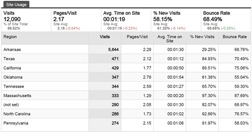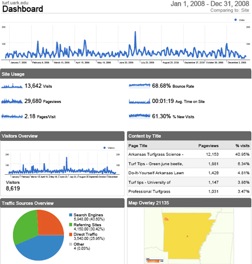 |
August 2010
|
August 2010 // Volume 48 // Number 4 // Tools of the Trade // v48-4tt1
Tracking the Impact of Your Web-Based Content
Abstract
Google™ Analytics is an easy-to-use Web analytics program that gives you insight into Web site traffic. Many Extension programs use the Web to distribute information. Extension program impact has traditionally been assessed through surveys or by the number of publications sold or requested, whereas tracking Web impact has been more difficult. Although site visits and page views could be tracked with previous Web analytics technology, Google™ Analytics allows for tracking of additional useful information. This article highlights a few useful features of Google™ Analytics and demonstrates how to track the impact of Web-based content.
Introduction
One of the challenges in Extension is to track program impact. Traditionally, impact could be measured with pre- and post-tests or surveys after a workshop, seminar, or demonstration. Additionally, the impact of publications could be tracked by the number sold or requested. Web site impact has traditionally been more difficult to assess, however.
Today, few Extension programs are without a Web site, but most Extension staff are in the dark on how to document the impact of that Web site. Web site impact has been assessed in the past using online surveys (Walker & Holden, 2000; Wiersma, 2007; Herring, 2008), mail surveys (Wiersma, 2007), or by tracking the number of visits, page views, and the location of visitors (Shaklee, Archer, & Glaze, 2004).
Web analytical software can track useful information such as: 1) How did visitors find your Web site?; 2) What keywords get clientele to your Web site?; 3) What connection speed are visitors using?; 4) Which Web browser are visitors using?; and 5) Which publications were downloaded most often? Additionally, new Web analytics software programs package this information into useful reports with attractive and interactive charts and maps. One tool that can be used by Extension to track a Web site's impact is Google™ Analytics.
Getting Started
Two turfgrass program Web sites <http://www.turf.uconn.edu; http://turf.uark.edu> were created in 2007 and began to track information using Google™ Analytics. Below are seven steps the authors used to begin tracking the impact of their Web sites.
Step 1. Create a Web site to track or manage.
Step 2. Sign-up for Google™ Analytics at http://www.google.com/analytics/. This is a free service.
Step 3. Provide basic information about your Web site including the Web site address or URL (uniform resource locator).
Step 4. Obtain html coding statements from Google™ Analytics (Figures 1 & 2).
Step 5. Insert html coding statements at the bottom of the source code of each Web site page (Figure 1).
Figure 1.
Example of General HTML Coding
Statement

Step 6. Exclude IP (internet protocol) addresses of the Web master and other key personnel using a filter to avoid skewing impact data.
Step 7. Insert html coding statements within the hyperlink code to track the number of times a file such as a .pdf (printable document format) is downloaded.
Figure 2.
Example of HTML Coding Statement
for Tracking Downloads

Visitors
Visitor traffic can be measured by several metrics in Google™ Analytics. Visitors, absolute unique visitors, page views, average page views, time on the Web site, bounce rate, and new visitors are among the most visible information in this section (Figure 3). United States and state map overlays and tabular format (Figures 4 & 5) also provide useful impact information on which cities/states where U.S. clientele are accessing the Web site from. Advanced features under this tab include creating benchmarks and analyzing visitor trends.
Figure 3.
Image Captured from the Visitor
Tab in Google™ Analytics

Figure 4.
Connecticut Map Overlay Showing
<http://www.turf.uconn.edu>
Visitor Location

Figure 5.
Visitor Location to <http://turf.uark.edu>
in Tabular Format

Traffic Sources
The traffic sources tab provides information on how clientele are landing on your Web site. A breakdown of the keywords used to find your Web site as well as the referring Web site and search engine are provided.
Content
The content tab highlights what the visitors are viewing on your Web site. Content can be viewed by overview, top content, content by title, top loading pages, and top exit pages. Top content will provide the most useful program impact information by listing which pages and documents are viewed most frequently and how many hits they have received.
Findings and Discussion
Information from the visitor tab of Google™ Analytics provides useful information for program impact reports. An average 30,000 pages were viewed on each turfgrass Web site in each year. Pages were viewed by people in 58 countries and territories with an average of 45% of the visits coming from their respective state clientele. Direct traffic accounted for an average of 28% of the visits, while referring Web sites and search engines accounted for 31% and 41%, respectively. Cost savings of $932 were documented by the 233 downloads of the 2006 University of Connecticut Turfgrass Annual Research Report, which was previously printed for $4.00 per copy and distributed free of charge. At the University of Arkansas, the publication "Bermudagrass Lawn Calendar" was the most commonly downloaded publication with an average of 222 copies downloaded each year, indicating the importance for clientele and need to keep this document up-to-date.
The dashboard tab provided in Google™ Analytics provides an overview of the information highlighted in the visitor, traffic sources, and highlight tabs (Figure 6). An Extension impact report can be generated from the dashboard tab in several formats (.pdf, .xml, .csv, .tsv) and emailed, saved or printed. The authors of this paper have found these reports useful to highlight the impact of their Web sites in annual review and promotion documents.
Despite all the unique features of Web analytics software programs, there are limitations. Unlike the Web usage surveys by Herring (2008) and Wiersma (2007), Web analytics will not provide the 1) email address of its visitors, 2) the age of its visitors, 3) their occupation, 4) the impact of the information on their production practices, 5) their familiarity with Extension, 6) their satisfaction with the Web site, or 7) if they would recommend the Web site to others.
Figure 6.
Dashboard View of
<http://turf.uark.edu>
Report from Google™ Analytics

Increasing Your Impact
Other information provided by Web analytics not useful for documenting impact can be useful for increasing impact. Data on keywords and referring Web sites (from traffic sources tab) is useful to make adjustments to the keywords used to design a Web site and lead to increased Web site visibility (Palmer, 2006). Languages, browser capabilities (including a breakdown of browsers used by visitors), and network properties (including network connection speed) are other useful metrics available through Web analytics that may be useful when creating or updating Web sites in order to make them more user-friendly and increase the number of repeat visitors (Samson, 1998).
Conclusion
Web analytics can be implemented with only a basic understanding of Web design and html code. Google™ Analytics is an easy-to-use Web analytics program that tracks the impact of your Web-based content. Enter the search term "Web analytics" in Wikipedia (http://wikipedia.org/) for more information on Web analytics and a list of Web analytics software programs. Additionally, books are available that offer advice for the beginner and the advanced programmer on the use of Web analytics.
References
Herring, P. (2008). Who's knocking at our door? Characterizing Extension's online clientele. Journal of Extension [On-line], 46(3) Article 3FEA4. Available at: http://www.joe.org/joe/2008june/a4.php
Palmer, D. (2006). Raising the visibility of Extension web sites. Journal of Extension [On-line], 44(1) Article 1TOT8. Available at: http://www.joe.org/joe/2006february/tt8.php
Samson, S. A. (1998). Technology issues for improving access to internet web sites for rural users. Journal of Extension [On-line], 36(4) Article 4TOT2. Available at: http://www.joe.org/joe/1998august/tt2.php
Shaklee, H., Archer, T., & Glaze Jr., J.B. (2004). On line and in touch: Meeting the challenges of communication for Extension professionals. Journal of Extension [On-line], 42(1) Article 1COM1. Available at: http://www.joe.org/joe/2004february/comm1.php
Walker, R. C., & Holden, L. A. (2000). Survey results from users of a dairy management Web site. Journal of Extension [On-line], 38(1) Article 1TOT1. Available at: http://www.joe.org/joe/2000february/tt1.php
Wiersma, J. J. (2007). Development and impact of an Extension Web site. Journal of Extension [On-line], 45(5) Article 5RIB5. Available at: http://www.joe.org/joe/2007october/rb5.php




